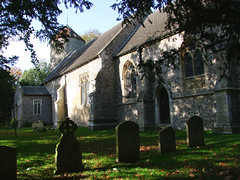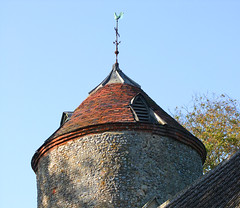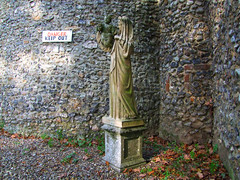| |
|
All
Saints, Welborne
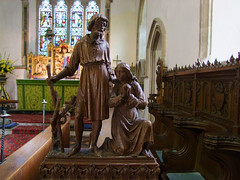 |
|
I
love Victorian churches, and I had long been
looking forward to coming back to All Saints.
When I was last here in 2006 the church was
locked without any keyholders listed, but I'd
been told there'd been a turnaround in thinking
here, and the church was now accessible.
Of course, this church isn't really
Victorian. It is one of the many medieval
round-towered churches in the Wensum valley to
the west of Norwich. But it was totalled in the
1870s at the expense of the Rector, John Barham
Johnson. He replaced the chancel, completely
refitted the shell of the nave, and finished off
the round tower with a brick course and conical
top. The tower is curiously short on openings,
making an age difficult to guess, but Detective
Pevsner noted the thickness of the nave west
wall, suggesting that the church was here before
the tower, as is common in this part of Norfolk.
This would place the tower no earlier than the
late Norman period. I looked forward to testing
this theory for myself.Everyone
speaks highly of Welborne. Even dear old Munro
Cautley, who ordinarily had any Victorian
architect who strayed onto his land dragged
behind the stable block and shot. He describes it
as beautifully restored. The funny thing
is, it isn't clear who the architect here
actually was. Could it have been Barham Johnson
himself?
|
My desire
to investigate the tower fell at the first hurdle - it
was cordoned off by a safety fence with a Danger -
Keep Out sign. It seems that the work of the 1870s
is coming to the end of its natural life, and tiles and
the like have started falling onto the heads of anyone
unfortunate enough to walk below. The tiny parish has set
in motion an ambitious plan to raise over a hundred
thousand pounds needed for the repairs, and jolly good
luck to them.
Well, the church still wasn't open, but there was now a
notice with four telephone numbers you could ring for the
key. I rang one. The man who answered seemed a little
unclear as to why I was ringing (I think I may have woken
him up) but eventually we negotiated that he'd come down
and open the church for us. And he did. He nipped in to
turn off the alarm, and we stepped into an utterly
beautiful space, a tiny yet full blown Anglo-catholic
interior of an age of confidence. My eyes were drawn to
the beautiful roodscreen in the style of the 15th
Century, and as if by magic the chancel came alive beyond
as the keyholder switched on the lights. Now, it was the
gorgeous reredos, Christ in Majesty flanked by the Lamb
of God and a Pelican in her Piety, which dominated the
church.
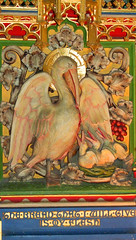 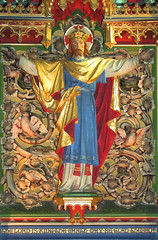 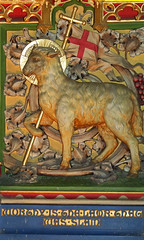
At one
time the liturgy here must have been the Highest of the
High, and although that is clearly no longer the case the
beauty of it survives. The furnishings are exquisitely
carved, those on the chancel stalls dominated by,
firstly, St Michael on the north side banishing Adam and
Eve from Paradise, who stand somewhat bewildered on the
south side. And then, further east, St Gabriel kneels in
supplication to the north while the young Virgin Mary
stands at her prayer desk to the south. It all must have
cost an absolute fortune - Barham Johnson must have been
a very wealthy man.
At
the north-west corner of the nave is a memorial
to Henry Barham-Johnson, son of the restoring
Barham Johnson. Henry followed his father as
Rector here. One of Henry's own sons, Geoffrey,
was killed in the First World War. Another son,
John, was a popular composer of piano and church
music. Both are remembered on the memorial with
him. Out in the porch window there is a curious
survival, a smattering of medieval stained glass
fragments. They came from the same collection as
the great sequence of Saints and Martyrdoms in
the church at North Tuddenham. They were found in
a builder's yard in Dereham in the 1880s, and
were bought for fifty shillings. The bulk was
installed at North Tuddenham, but the Rector gave
the odd bits left over to Welborne. Some of the
fragments of inscription here match bits of
inscription in the other church, and are part of
a massive sequence of the life and martyrdom of
St Margaret. No one knows where it all came from
originally. It must have been a big church.
And at last we stepped outside, blinking in the
low sunshine. A statue of the Blessed Virgin and
child stands to the west of the porch, a relic of
Anglo-catholic days, and the pleasing little
churchyard is completed by one of Norfolk's best
lychgates in the Arts and Crafts style. It was
all very satisfying. The keyholder gave us a
cheery wave, and we set off for Mattishall. |
|
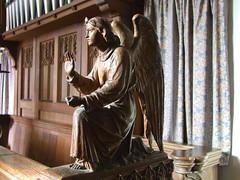 |
Simon Knott, October 2014, updated
August 2015
|
|

